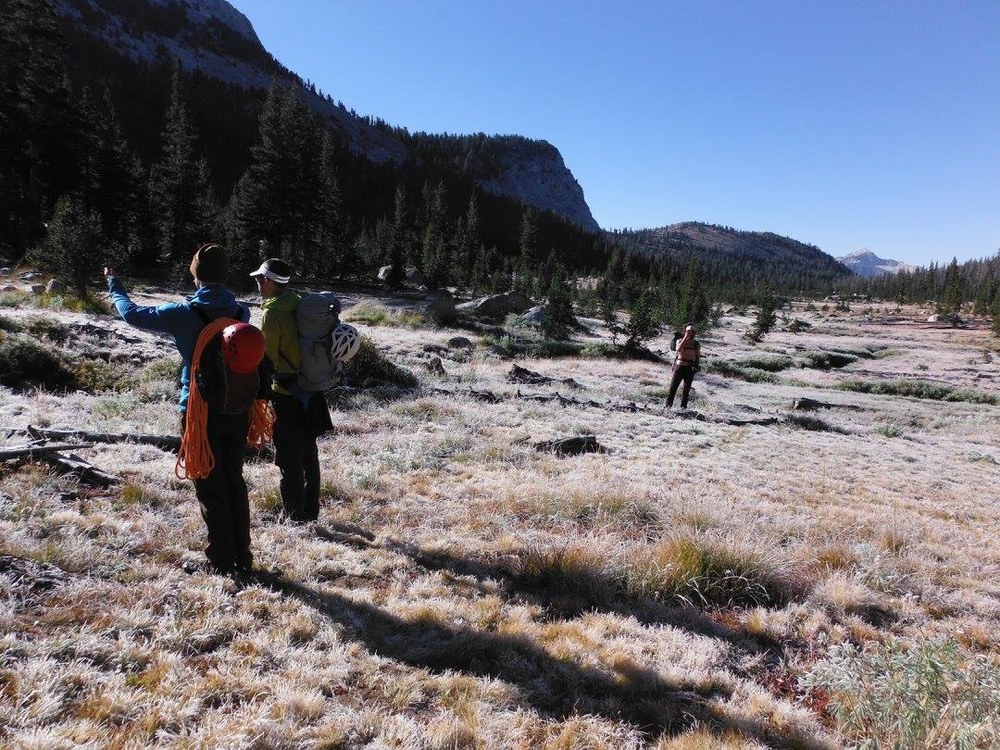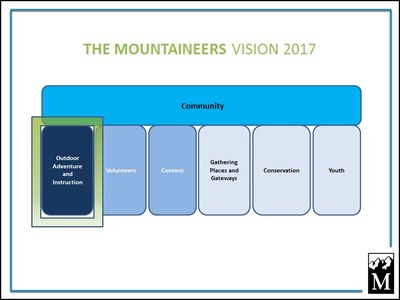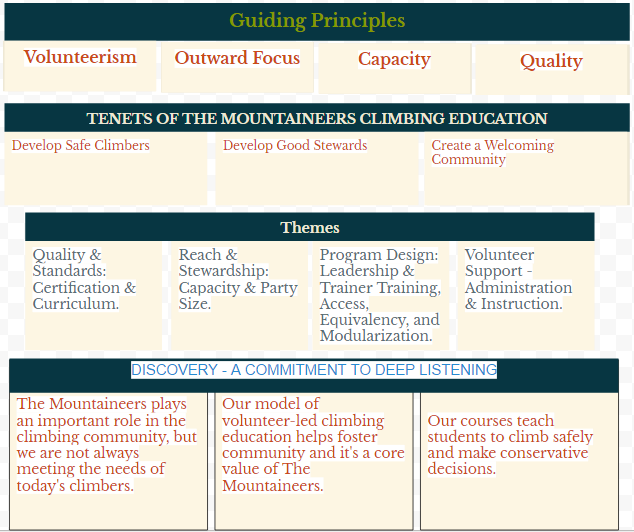
Earlier in 2016, The Mountaineers Board of Directors voted to allocate funds to a project we’re calling Progressive Climbing Education. The goal is to dedicate resources to advance the goals and initiatives of our passionate volunteers. Done well, these strategic investments will make our suite of volunteer-led Climbing Programs more fun for volunteers to run, easier to recruit volunteers for, more attractive to new climbers (especially those coming out of the gym), and more advanced for our highly-skilled volunteers and students.
Background
In 2012, the Board of Directors developed a 5-year strategic plan, and we are in the final year of this plan. The plan included investments in 6 areas, with an overarching goal of building our community. We launched a suite of youth programs, redesigned our conservation program, invested in program centers, created new content through our new website and our e-learning pilot, and hired a Leadership Development Manager to support our volunteers.

What’s left is “outdoor adventure and instruction”. Grass-roots momentum among our climbing committees has helped us re-imagine how our climbing programs can better suit the needs of our students and volunteers, and so we decided to focus the initial scope of our outdoor adventure and instruction initiative on climbing. We felt the readiness and enthusiasm among our volunteers, and want to invest strategic resources to support our volunteer efforts.
In many ways this project is all about investing in and accelerating ideas our volunteer leaders have wanted to tackle for years. This effort is what we're now calling our Progressive Climbing Education initiative.
Discovery - A commitment to deep listening
Our first step was to make sure we truly understood the needs of our volunteers running our climbing programs, and of the community at large, including our students. We had three listening sessions in June with more than 60 Mountaineers climbers and outside community members providing input.
Following the Listening Sessions, we conducted in-depth interviews with 10 individuals - a mix of volunteers, staff and non-Mountaineers members of the climbing community. We also conducted a community-wide survey soliciting input from the greater climbing community, which received upwards of 200 responses.
Through all of this, some clear themes emerged.
- The Mountaineers plays an important role in the climbing community, but we are not always meeting the needs of today's climbers. Our climbing courses are designed to help those with hiking experience move onto more technical terrain. Today, many people are learning to climb in the gym and have advanced rock skill but little to no outdoor experience. Others come wanting to learn only one component of climbing, and our courses are designed to be comprehensive thereby requiring students to learn components that don't interest them. Many of our courses have long waitlists - we aren't meeting the growing need in the PNW. By redesigning our program progression and offering shorter, more specific modules, we may be able to meet more of the needs of the growing climbing community.
- Our model of volunteer-led climbing education helps foster community and it's a core value of The Mountaineers. Our current volunteer-led model limits our capacity and leads to volunteer burn-out. Restructuring our volunteer model and adding paid staff supports in key roles can help expand our volunteer capacity and enhance the volunteer experience.
- Our courses teach students to climb safely and make conservative decisions. On the other hand, our techniques are sometimes viewed as rigid or outdated and our instruction can lack consistency with nationally recognized practices across branches and even within a course. We do not often emphasize efficiency, judgment, or decision-making skills, and our students can be ill-equipped to move efficiently in the mountains causing back-ups on popular routes and poor climbing and LNT ethics. We have opportunities to improve our performance in the mountains with smaller and better equipped parties, greater consistency, and greater capacity.
The Climbing Education Advisory Committee (CEAC)
To help ensure that we have inputs on this initiative from both inside and outside our organization, we built a Climbing Education Advisory Committee to add some serious brain power as we move through this process.
The CEAC has met three times in the past three months and will be meeting again in November. At each meeting, the group reflects on community input over the past month and refines the goals and the messages.
FROM THE GREATER CLIMBING COMMUNITY
- Dave Haavik, Petzl/Washington Climbers Coalition
- Melanie Hodgman, REI Outdoors School
- Rich Johnston, Vertical World
- Forest McBrian, AMGA guide
- Joe Sambataro, Access Fund
- Steve Smith, Student Conservation Association and Outward Bound
- Martin Volken, AMGA guide
- Andy Wyatt, Seattle Bouldering Project
FROM THE MOUNTAINEERS
- Steve Anderson, Kitsap Climbing Committee (anderson.stevej@gmail.com)
- Nick Mayo, Everett Climbing Committee (nicholas.e.mayo@gmail.com)
- Stefanie Schiller, Seattle Climbing Committee (stefs67@gmail.com)
- Tony Tsuboi, Everett Climbing Committee (tony.tsuboi@gmail.com)
- Loni Uchytil, Seattle Climbing Committee (loniuchytil@msn.com)
- Janette Zumbo, Olympia Climbing Committee (janettezumbo@gmail.com)
Simplifying the Message
TENETS OF THE MOUNTAINEERS CLIMBING EDUCATION:
- Develop Safe Climbers – We will educate as many climbers as possible, striving not to turn away potential students. We will teach current techniques, while matching our standards with other organizations, teaching good decision-making skills, and helping climbers grow and develop at all levels, including leadership.
- Develop Good Stewards – We will reach as many climbers as possible, holding our leaders and instructors to high standards for modeling stewardship, while teaching climbers to minimize their impact and promoting small party size.
- Create a Welcoming Community – We will welcome new climbers and climbers new to the area, facilitating mentorship at all levels, and helping all climbers enter the community regardless of their climbing background. We will also welcome new techniques and new perspectives on climbing.
These tenets have helped guide our decisions and priorities and will continue to do so as we move forward.
Themes
As we met with individuals, climbing committees and the CEAC, several themes surfaced as key opportunities:
- Quality & Standards: Certification & Curriculum. There have been a lot of discussions about ways to improve our consistency across branches, courses, and with the greater climbing community. By taking a hard look at our curriculum standards and working with partners like the American Alpine Club, we can improve the quality of experience for our students, volunteers and the community. Some ideas include: adopting national AAC standards, utilizing e-learning platforms, and creating skills-based modules. You can read more here.
- Reach & Stewardship: Capacity & Party Size. We heard a lot that we need to reduce our party size to reduce our impact on popular routes, but at the same time we heard the need to expand our reach and reduce our wait lists. We recognize the importance of meeting the educational needs of a growing climbing community and want to do so with minimum impact and teaching an ethic of stewardship. Some ideas include: investing in volunteer support, teaching a standard climbing ethic, reducing our party size on the most popular routes, finding alternative locations to high-use areas, and reviewing our graduation requirements. You can read more here and here.
- Program Design: Leadership & Trainer Training, Access, Equivalency, and Modularization. As noted above, our climbing program was designed to meet the needs of people in a different era. We heard repeatedly the need to make it much easier to get involved and stay involved in The Mountaineers. This includes ideas like providing advanced training for our volunteers and train the trainer opportunities. It also includes creating smaller skills-based modules to meet the needs of busy adults and students who may come with some climbing skills. If we had a streamlined equivalency program, we could easily welcome climbers at any level into our community. Expanding locations could provide access to climbing programs for more communities. Read more here.
- Volunteer Support - Administration & Instruction. Through everything, we realized that most important is to support our volunteers. If we are going to increase our capacity, reduce our impact, offer advanced options, expand our community, improve our consistency, and maintain the core value of volunteerism, we must evaluate our human resources - paid and volunteer. We need to look at where we need to invest to provide the best support for our volunteers so that we can achieve all of these things. Ideas have included hiring administrative support staff, hiring recruitment support, hiring an equivalency manager, sending volunteers to industry training events, and hiring certified guides to teach advanced courses. Read more here and here.
Four Guiding Principles
As we move forward we have a lot of decisions to make about where to invest first, where to move quickly, where to move cautiously, and how do we measure success. We've developed four guiding principles that we are committed to considering with every decision.
- Volunteerism - Decisions and actions must support the volunteer culture, enhance the volunteer experience and build a vibrant community.
- Outward Focus - Decisions and actions should seek out partnerships with like-minded organizations to expand capacity, share resources, protect our wild places and reach more climbers.
- Capacity - Decisions and actions should support a community that welcomes everyone, with the ideal of making everyone a safe climber and good steward.
- Quality - Decisions and actions should build on a legacy of pioneering climbing education and grow that legacy as a long-term, high-quality, and sustainable force in the climbing community.
What's next
Join Us!
THREE TOWN HALL MEETINGS ARE SCHEDULED FOR:
In these town hall meetings, we'll seek your input on these ideas and more. Please join us and invite others. We want as much input as possible.
Add a comment
Log in to add comments.Why aren't there any comments on this blog. In my mind this is a hot topic. I am surprised that there seems to be no interest.
@Mark G. Hello; thought I'd comment on how the websites "commenting" is clunky compared to what's in the forefront of such technology, which is Discourse [https://www.discourse.org/]. I'd love to see the Mountaineers use a 'real' discussion tool, of the aforementioned. Maybe if enough members vote this feature [http://feedback.mountaineers.org/forums/273688-general-feedback/suggestions/6783184-message-board-for-leaders-and-members-wanting-to-c] we can attain one of the tenants for PCE.
As human beings, one of our strengths is our spatial memory. I've taken the contents of this page and spatially arranged it, i.e. made a diagram. It's a Google Drawings [https://docs.google.com/drawings/d/1YBfw3dCdUlYKpwVwn0w8NxFeWUWqJQ0sS5LFGvXbn18], just copy and paste the link --without the brackets "[]"-- into a browser {Firefox, Chrome --all other browsers are dead to me}.
Thanks so much for the great image, David! We've incorporated it into the blog above!
I am wondering why this group never contacted the Climb Chairs Committee after this group had an outside reviewer give feedback on our Basic climbing course and after this group worked on common curriculum agreement for all branches for this course? Seems like that would have been a good group to work with?
Hi Jim,
Thanks for the question. Our goal was (and continues to be) as broadly inclusive a process as possible. We involved climbing chairs by: seeking climbing committee representation on the CEAC, seeking input through listening sessions and surveys, posting updates regularly on a blog and through Leader Lines as well as on branches' facebook pages, and visiting climbing committees in Seattle, Tacoma, Olympia and Everett to make a special presentation and solicit input. We will be holding a climbing chairs' summit in December to review the preferred options and seek further input.
With regard to the curriculum review, this will absolutely be relevant in the next phase of the Progressive Climbing Education project. While we haven't outlined the specific actions for the next phase just yet, most certainly the first part of implementation will be gathering the right people at the table for each of the elements we'll be implementing. Any strategic project around curriculum would certainly seek to involve the folks involved in the AMGA review and build off of that base.
Thanks again for your comment and participation.
As to professional trainning, maybe just climbing techniuqes such as warter fall ice, crack climbing, ect but as far as overall alpinisim, no. I have taken the amga alpine course and it is set up for teaching guides how to lead clients.
 The Mountaineers
The Mountaineers
